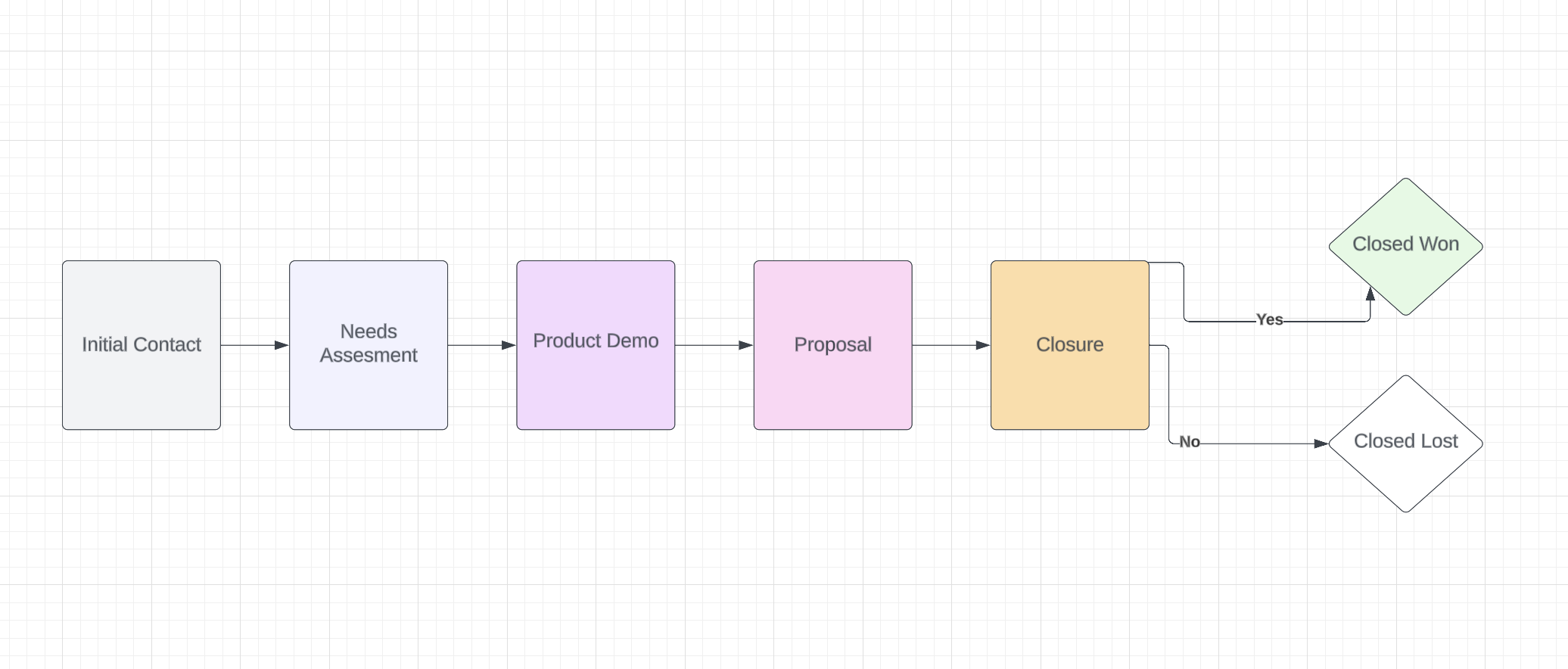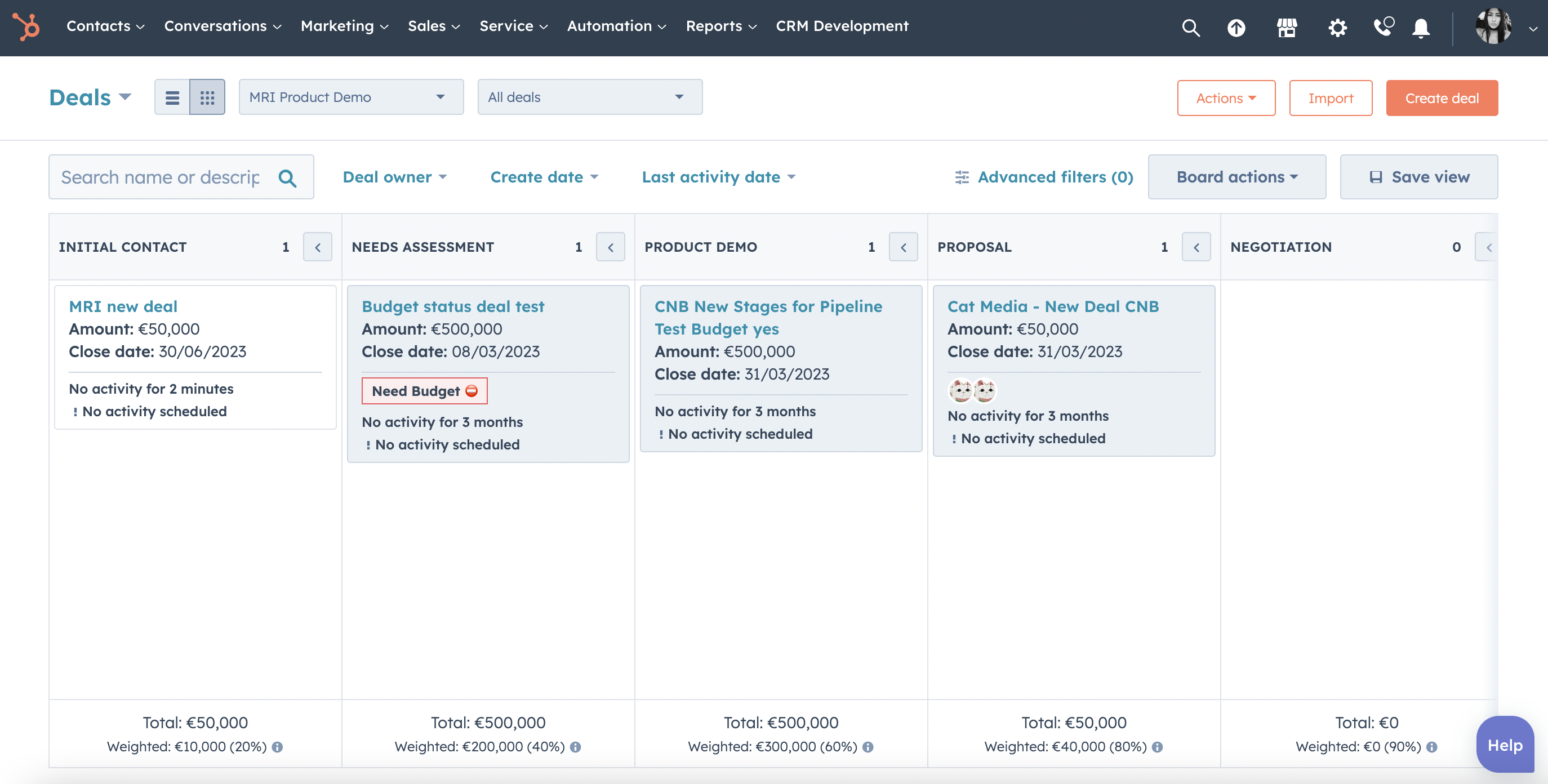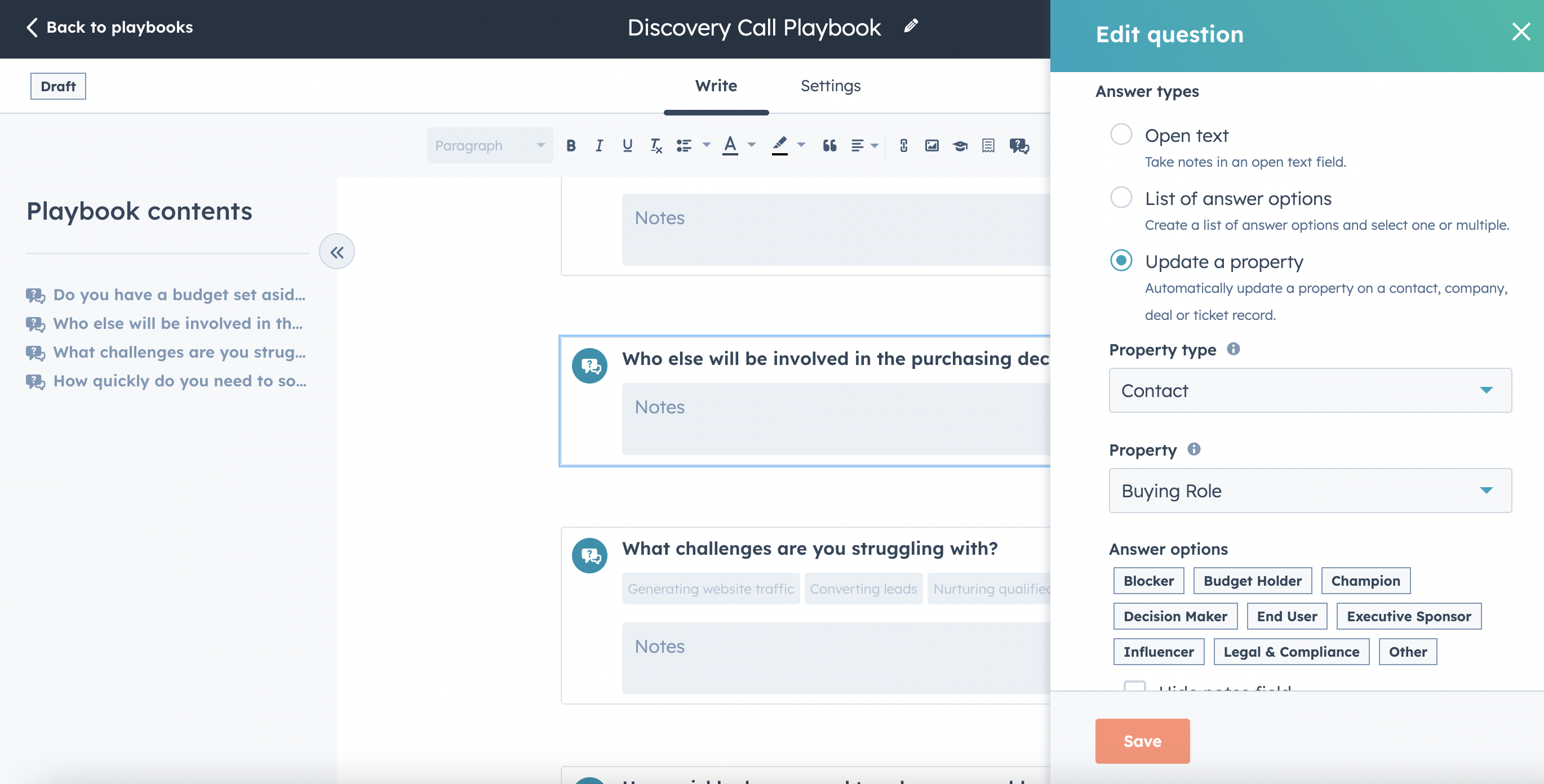To succeed in today's competitive business landscape, a well-designed and efficient sales process is crucial for generating revenue. With a clear strategy, your sales team may be able to navigate customer interactions effectively. But how can you ensure your sales process aligns with your customer's journey while boosting performance?
In this blog post, we'll explore the steps to build an efficient sales process. We'll cover everything from mapping sales stages to the buyer's journey, standardising the process for consistency, and using metrics to improve. So join us as we unlock the secrets to creating a sales process to elevate your team's performance.
Mapping the Buyer's Journey: The Genesis of a Productive Sales Process
Before you can define your sales process, you have to understand who you’re selling to. Once you know who you’re selling to, you need to understand the sales process from their perspective.
The buyer’s journey is the active research process someone goes through leading up to a purchase. To bring this to life, Mapping the buyer's journey is the foundation of a productive sales process. By tailoring the process to the buyer's unique needs, you enable your sales reps to guide prospects through the funnel seamlessly.
 Source: HubSpot
Source: HubSpot
The mapping process involves defining the necessary steps that your sales representatives must take, from initial contact to final sale. Your sales process should be flexible enough to accommodate different prospects' needs while still maintaining a sense of structure that helps your reps achieve their goals.
The goal is to create a roadmap that guides your reps towards success while allowing them to retain their individuality and flexibility. By doing so, you'll create a sales process that's both effective and adaptable, capable of achieving the best possible outcome for both your team and your customers. So define your target persona and their buyer journey, and then you’ll have a great starting point for building a customer-centric sales process.
Example Business Model: Perpetual Ownership
Imagine your company sells an innovative MRI machine that offers more precise imaging and patient comfort. Your target persona is likely the Head of Radiology or perhaps even the Chief Medical Officer (CMO) at large healthcare institutions.
In the initial 'awareness' stage of their buyer's journey, these decision-makers might be experiencing challenges with their current MRI machines, such as limited image resolution or patient discomfort during the scans. At this stage, marketing can generate informative content about the prevalent issues with traditional MRI machines, establishing your company as a knowledgeable entity in this field. This content could be in the form of blog posts, whitepapers, webinars, or educational videos. Your sales team can then share this content when making initial contact, offering potential solutions and subtly introducing your advanced MRI machine.
Your sales representatives' task would be to empathize with these issues. They should make initial contact and offer insightful content about how your state-of-the-art MRI machine can alleviate these specific problems.
In the 'consideration' stage, these healthcare professionals are evaluating potential solutions to their challenges. Marketing can provide comparative studies, product specifications, or expert articles showcasing your MRI machine's superior capabilities; these materials can be utilized by your sales reps to construct a compelling case for your product, showcasing its superior precision, patient comfort, and perhaps even how it can lead to more accurate diagnosis and better patient outcomes.
Finally, during the 'decision' stage, these decision-makers are ready to select a solution. Your sales team's role is to provide detailed product demonstrations, share success stories from other healthcare institutions, and address any remaining doubts or concerns. Marketing can offer testimonials, case studies, or success stories that your sales reps can use to bolster their product demonstrations. Here, marketing's role is crucial in assuring the prospect of the efficacy and reliability of your MRI machine through social proof.
This is a simplified example, but it illustrates how understanding and mapping the buyer's journey informs the steps of your sales process. From awareness to decision, your sales process should mirror your customer's needs and challenges, enabling your sales reps to offer the most appropriate interaction at every stage. This alignment not only helps in closing the sale but also builds trust and long-term relationships with your clients.
Therefore, while your sales team is instrumental in directly communicating and building relationships with the clients, your marketing team plays a crucial supporting role, providing valuable content at each step of the buyer's journey. This sales-marketing alignment (or 'smarketing') ensures a consistent message across all customer touchpoints and moves your prospects smoothly through the sales funnel.
Establishing Exit Criteria: Guiding Steps for a Smooth Sales Flow
The concept of defining clear exit criteria for each stage of your sales process is paramount. These criteria indicate what needs to happen for a sale to move from one stage to the next. From collecting certain information from the prospect to securing specific commitments, each step should focus on facilitating the buyer's progress.
Let's assume we have divided our sales process into the following main stages: Initial Contact, Needs Assessment, Product Demonstration, Proposal, Negotiation, and Closure.

Example sales process stages
Each of these stages requires its unique exit criteria to ensure a smooth sales flow:
-
Initial Contact: The exit criterion for this stage could be successfully scheduling a discovery call with the Head of Radiology or the CMO.
-
Needs Assessment: In this stage, your sales reps are trying to understand the prospects' challenges and needs in-depth. The exit criteria could be having a clear understanding of their current imaging challenges, their patient comfort concerns, and what features they would want in their ideal MRI machine.
-
Product Demonstration: Here, your representatives demonstrate how your MRI machine addresses their specific needs. The exit criterion for this stage could be the prospect expressing a clear interest in your product and requesting a proposal.
-
Proposal: At this stage, the sales rep delivers a customized proposal detailing the machine's specifications, pricing, and service support. The exit criteria here might be the prospect's acknowledgement of the proposal and an agreement to enter into the negotiation or consideration phase.
-
Negotiation: This stage involves addressing any concerns and agreeing upon the terms of the purchase. The exit criteria might be the final agreement on the price, delivery, installation schedules, and after-sales service details.
-
Closure: The final stage, where the prospect becomes a customer. The exit criterion here would be a signed contract and perhaps an established schedule for product delivery and installation.
The exit criteria should always correlate with helping the prospect advance in their buying journey. By mapping these exit criteria to each stage, your sales reps have a clear understanding of what needs to be accomplished to keep the sales process moving forward.
Simplifying and Optimising: Fitting Your Sales Process within Your CRM
Following the detailing of steps and their exit criteria, the next challenge lies in simplifying it for adequate storage and monitoring within a CRM. A streamlined process should meet four criteria: required, factual, inspectable, and buyer-centric, ensuring each stage is necessary, action-based, verifiable, and focused on the buyer's perspective.
- Required: Steps that your sales reps must undertake in every sale, without exception.
- Factual: Steps tied to a specific action, offering a clear-cut completion status.
- Inspectable: Steps that can be verified within the CRM, tied to actions your sales reps take.
- Buyer-Centric: Steps focused on the buyer's perspective, making the buyer feel more involved in the process.
Let's continue with our medical hardware company and how it can leverage HubSpot to map its sales process:
To begin with, our sales process stages (Initial Contact, Needs Assessment, Product Demonstration, Proposal, Negotiation, and Closure) can be represented as deal stages in HubSpot.
 Deal Pipeline in HubSpot example - Source: HubSpot
Deal Pipeline in HubSpot example - Source: HubSpot
-
Required: We will set up each stage in HubSpot's pipeline to match the necessary steps our sales reps must undertake. For example, the 'Needs Assessment' stage in HubSpot will require the rep to input the identified needs of the prospect before the deal can move to the 'Product Demonstration' stage.
-
Factual: We'll use custom fields to ensure factual tracking. For instance, in the 'Product Demonstration' stage, a custom checkbox field such as 'Demonstration Completed' will ensure that the demonstration has indeed taken place.
-
Inspectable: HubSpot's Activity Tracking will help us inspect each step. For instance, connecting your email to HubSpot so you can email features that track the sending of a proposal, document views to leverage when the opportunity is in the 'Proposal' stage, and call features you can log the negotiation details in the deal is the 'Negotiation' stage.
-
Buyer-Centric: Finally, we'll use notes and contact properties to record crucial information about the buyer's journey, such as their reactions to the product demo or any particular concerns they expressed and tasks to organise and execute those strategic touch-points in the sales process. This way, our sales reps can approach each negotiation from a buyer-centric perspective, focusing on resolving these concerns.
In terms of simplification, HubSpot's clean interface and visual sales pipeline make it easy for reps to see where each deal is at a glance, ensuring the entire sales process is understandable and easily followed. This visual representation can help highlight any bottlenecks or stages where deals are getting stuck, allowing for real-time analysis and improvement of the sales process.
A well-crafted sales process in your CRM can boost your team's productivity and offer valuable insights into your prospects' behaviour, facilitating continuous refinement.
Tracking and Analysing Sales Metrics: The Key to Continuous Improvement
In order to continuously improve your sales process based on the buyer's journey, it's important to track key metrics such as lead conversion rates, deal cycle times, deal sizes, and win rates. However, it's crucial to avoid making sudden changes based on small sample sizes. Instead, look for trends that persist over time and across numerous deals. By doing so, you can identify potential areas for improvement and refine your approach accordingly.
After having established a sales process within HubSpot that is mapped to our buyer's journey, we'll now set key performance indicators to measure the efficiency of our process.
Let's consider some of these metrics:
-
Lead Conversion Rates: In our medical hardware business, we might find that we're generating plenty of leads through our marketing efforts, but only a small percentage of these leads are being converted into opportunities. By tracking this rate in HubSpot, we can identify potential bottlenecks in our qualification process that may be causing us to lose potential customers. We may need to provide additional training to our reps about qualifying leads or tweak our lead-scoring criteria.
-
Deal Cycle Times: Suppose we notice that the time from the initial contact to closure is longer than our industry average. In this case, we could delve deeper into each stage to pinpoint where the delays are happening. Perhaps the 'Product Demonstration' stage is taking longer due to scheduling issues or technical difficulties. Based on this, we can find solutions, like improving our demo scheduling process or enhancing our demo setup.
-
Deal Sizes: If the deal sizes are smaller than expected, it could indicate a misalignment in targeting the right prospects or a potential issue with our pricing strategy. Tracking average deal size over time can help us detect any concerning trends and make necessary adjustments.
-
Win Rates: Imagine our win rates are lower than the industry standard. By analysing the lost deals in HubSpot, we might discover a common point where the deals are falling through, for instance, during the 'Negotiation' stage. This could indicate that our competitors are offering more favourable terms, or we might need to improve our negotiation skills.
Integrating Marketing Metrics for a Holistic View
The confluence of marketing and sales metrics presents a panoramic view of your sales process. Primarily, monitoring lead sources and lifecycle stages within HubSpot can inform and refine your sales strategies. If a sizable portion of leads originates from a specific marketing channel like a healthcare blog, amplifying similar content could boost lead generation.
In HubSpot, lifecycle stages are pivotal in tracking a lead's journey through the sales funnel. A detailed examination of these stages, such as how swiftly leads transition from 'Lead' to 'Marketing Qualified Lead' (MQL) and subsequently to 'Sales Qualified Lead' (SQL), reveals the marketing and sales velocity. Protracted transitions suggest the need to enhance lead nurturing strategies or sales response times, ensuring no opportunities slip through the cracks.
By seamlessly integrating these marketing metrics with sales data, you create a 360-degree perspective of your sales process. This comprehensive view enables more targeted refinement of your sales and marketing alignment, fostering a more efficient buyer's journey, and enhancing overall sales performance.
Standardising the Sales Process: A Roadmap for Consistency and Success
It'd be important that you'll be able to make sure that your team is consistent. It provides a roadmap for your reps, giving them a proven path to follow and the freedom to adapt the process to each deal's unique context. In addition, a standardised sales process ensures that every rep, from veterans to new hires, understands their responsibilities at each sales cycle stage.
Standardization is key for our sales team to ensure each rep understands their role and how they contribute to the overall sales process. With the sales process now implemented in HubSpot, the next crucial step is to create a standardized guide or playbook for our sales team.
Example:
The playbook should begin with prospecting. For instance, our medical hardware company targets hospitals and clinics primarily. Therefore, every sales rep should know the best practices to identify and reach out to these potential customers. This could be through LinkedIn prospecting, attending medical conferences, or leveraging existing connections in the healthcare industry.
As they move into qualification, our reps should know what questions to ask to determine whether a lead is a good fit. What kind of medical hardware do they currently use? Are they facing any challenges with their current setup? What's their budget? Clear guidelines here ensure no critical information is missed during this stage.
In many business models, especially those with a larger or more specialised sales force, the 'Initial Contact' stage is often handled by a Sales Development Representative (SDR). Once the SDR has established initial contact and qualified the lead, they then book a discovery meeting with a sales rep. The sales rep will then take over from the 'Needs Assessment' stage.

HubSpot Playbooks tool: Discovery Call Playbook Example - Source: HubSpot
From this point on, the sales rep guides the prospect through the rest of the sales process, from 'Product Demonstration' to 'Proposal', 'Negotiation', and 'Closure'.
Next, in the presentation, our reps should understand how to demonstrate our medical hardware effectively. This could include running through a standard demo script that's been designed to showcase the key features of our product that solve the common pain points of hospitals and clinics.
When it comes to proposing, negotiating and closing, our sales reps should be equipped with strategies to handle common objections and understand the flexibility they have in terms of pricing and contracts. These stages would also cover how and when to involve sales managers or other team members to help close the deal.
Finally, every sales rep should understand the proper way to hand over a new customer to the onboarding and customer success teams, ensuring a seamless transition and maintaining customer satisfaction. By providing them with a roadmap to follow, we ensure consistency across the sales team, making it easier to onboard new reps, conduct effective sales training, and provide targeted coaching, all while maintaining the adaptability needed to cater to each deal's unique circumstances. This way, we ensure the medical hardware company's sustained growth and success.
Final Takeaway: Constant Refinement for Scalable Revenue Growth
Defining your sales process requires a deep understanding of your buyer's journey, refining it through sales metrics, and standardising it for consistency. Investing time and resources in building and refining your sales process, you stand to reap significant returns. Not only does a well-defined sales process lead to predictable and scalable revenue growth, but it also improves overall team performance, facilitates onboarding new reps, and provides a basis for effective sales training and coaching.
Building and perfecting a sales process is an iterative journey.
The journey to an effective sales process is ongoing, marked by constant evaluation, improvement, and iteration - one that requires a profound understanding of your buyer's journey, continuous refinement through marketing and sales metrics, and standardisation for consistency.

For our high-tech medical hardware company, this means deeply understanding the needs and pain points of healthcare professionals and decision-makers within medical institutions. From the moment the SDR makes the initial contact to the point where the sales rep closes the deal, each step in the sales process must be closely aligned with the buyer's journey. In our hypothetical scenario, this might mean refining the 'Needs Assessment' stage better to identify the medical institution's specific pain points or improving the 'Product Demonstration' stage to showcase better how the medical hardware can alleviate these pain points.
Marketing and Sales Alignment
However, the sales process doesn't stop there. Marketing plays a synergistic role alongside sales, facilitating a smoother transition through the buyer's journey. Marketing's contribution to creating awareness about prevalent MRI machine issues, showcasing the superior capabilities of our product, and providing social proof through success stories, all serve to bolster the sales process.
Metrics from both sales and marketing are instrumental in refining the process. Tracking key sales metrics such as lead conversion rates and deal cycle times can help pinpoint areas in the sales process that need improvement. Simultaneously, marketing metrics like content engagement rates, lead generation, and lead conversion provide insights into the effectiveness of marketing strategies and their contribution to the sales process.
The standardisation of the sales process ensures consistency across the sales force, providing a clear, proven path for all sales reps to follow. This boosts team performance, makes onboarding new reps easier, and forms a solid foundation for effective sales training and coaching. However, standardisation should also accommodate the dynamic nature of marketing. The strategies within your sales process should remain flexible and adaptable, open to innovation, and responsive to evolving marketing trends.
Just like the high-tech medical hardware it sells, the company's sales process should be cutting-edge, efficient, and ever-evolving, in line with industry trends and customer expectations. A well-defined sales process is not just about closing a deal; it's about building trust, providing value, and forging long-term relationships with your customers.


.png)